instrument cluster SKODA SUPERB 2003 1.G / (B5/3U) Owner's Guide
[x] Cancel search | Manufacturer: SKODA, Model Year: 2003, Model line: SUPERB, Model: SKODA SUPERB 2003 1.G / (B5/3U)Pages: 259
Page 172 of 259
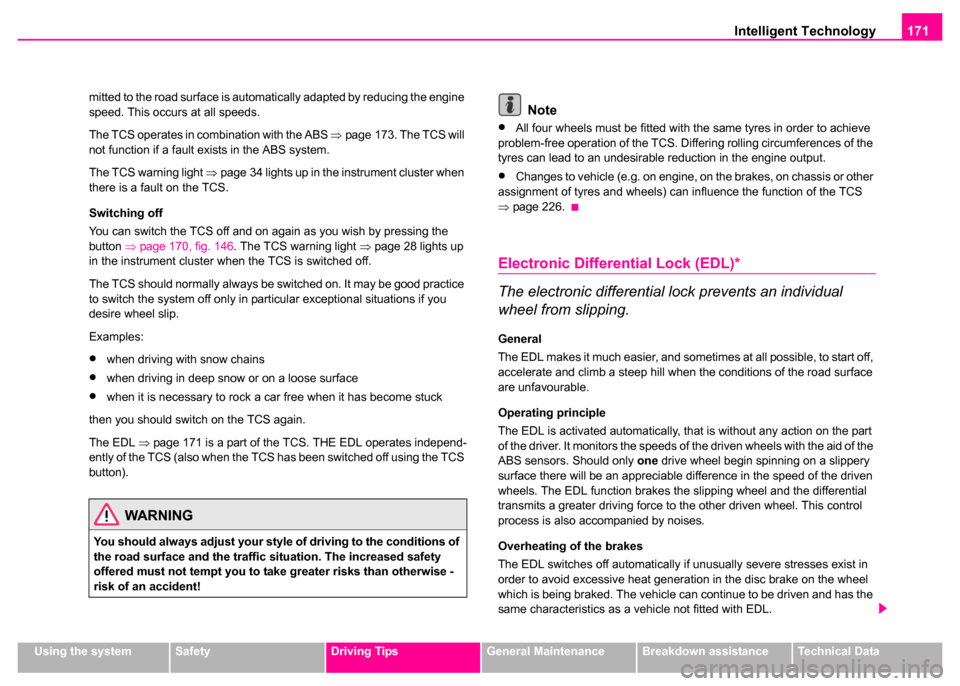
Intelligent Technology171
Using the systemSafetyDriving TipsGeneral MaintenanceBreakdown assistanceTechnical Data
mitted to the road surface is automatically adapted by reducing the engine
speed. This occurs at all speeds.
The TCS operates in combination with the ABS
⇒page 173. The TCS will
not function if a fault exists in the ABS system.
The TCS warning light ⇒page 34 lights up in the instrument cluster when
there is a fault on the TCS.
Switching off
You can switch the TCS off and on again as you wish by pressing the
button ⇒page 170, fig. 146 . The TCS warning light ⇒page 28 lights up
in the instrument cluster when the TCS is switched off.
The TCS should normally always be switched on. It may be good practice
to switch the system off only in particular exceptional situations if you
desire wheel slip.
Examples:
•when driving with snow chains
•when driving in deep snow or on a loose surface
•when it is necessary to rock a car free when it has become stuck
then you should switch on the TCS again.
The EDL ⇒page 171 is a part of the TCS. THE EDL operates independ-
ently of the TCS (also when the TCS has been switched off using the TCS
button).
Note
•All four wheels must be fitted with the same tyres in order to achieve
problem-free operation of the TCS. Differing rolling circumferences of the
tyres can lead to an undesirable reduction in the engine output.
•Changes to vehicle (e.g. on engine, on the brakes, on chassis or other
assignment of tyres and wheels) can influence the function of the TCS
⇒ page 226.
Electronic Differential Lock (EDL)*
The electronic differential lock prevents an individual
wheel from slipping.
General
The EDL makes it much easier, and sometimes at all possible, to start off,
accelerate and climb a steep hill when the conditions of the road surface
are unfavourable.
Operating principle
The EDL is activated automatically, that is without any action on the part
of the driver. It monitors the speeds of the driven wheels with the aid of the
ABS sensors. Should only one drive wheel begin spinning on a slippery
surface there will be an appreciable difference in the speed of the driven
wheels. The EDL function brakes the slipping wheel and the differential
transmits a greater driving force to the other driven wheel. This control
process is also accompanied by noises.
Overheating of the brakes
The EDL switches off automatically if unusually severe stresses exist in
order to avoid excessive heat generation in the disc brake on the wheel
which is being braked. The vehicle can continue to be driven and has the
same characteristics as a vehicle not fitted with EDL.
WARNING
You should always adjust your style of driving to the conditions of
the road surface and the traffic situation. The increased safety
offered must not tempt you to take greater risks than otherwise -
risk of an accident!
Page 187 of 259
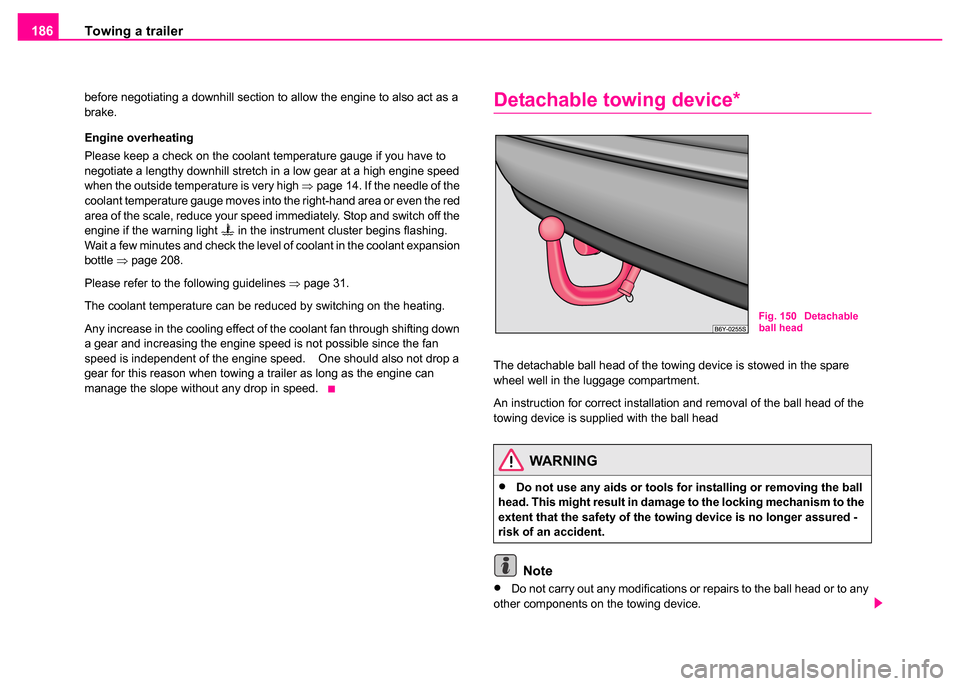
Towing a trailer
186
before negotiating a downhill section to allow the engine to also act as a
brake.
Engine overheating
Please keep a check on the coolant temperature gauge if you have to
negotiate a lengthy downhill stretch in a low gear at a high engine speed
when the outside temperature is very high ⇒page 14. If the needle of the
coolant temperature gauge moves into the right-hand area or even the red
area of the scale, reduce your speed immediately. Stop and switch off the
engine if the warning light
in the instrument cluster begins flashing.
Wait a few minutes and check the level of coolant in the coolant expansion
bottle ⇒page 208.
Please refer to the following guidelines ⇒page 31.
The coolant temperature can be reduced by switching on the heating.
Any increase in the cooling effect of the coolant fan through shifting down
a gear and increasing the engine speed is not possible since the fan
speed is independent of the engine speed. One should also not drop a
gear for this reason when towing a trailer as long as the engine can
manage the slope without any drop in speed.
Detachable towing device*
The detachable ball head of the towing device is stowed in the spare
wheel well in the luggage compartment.
An instruction for correct installation and removal of the ball head of the
towing device is supplied with the ball head
Note
•Do not carry out any modifications or repairs to the ball head or to any
other components on the towing device.
WARNING
•Do not use any aids or tools for installing or removing the ball
head. This might result in damage to the locking mechanism to the
extent that the safety of the towing device is no longer assured -
risk of an accident.
Fig. 150 Detachable
ball head
Page 207 of 259
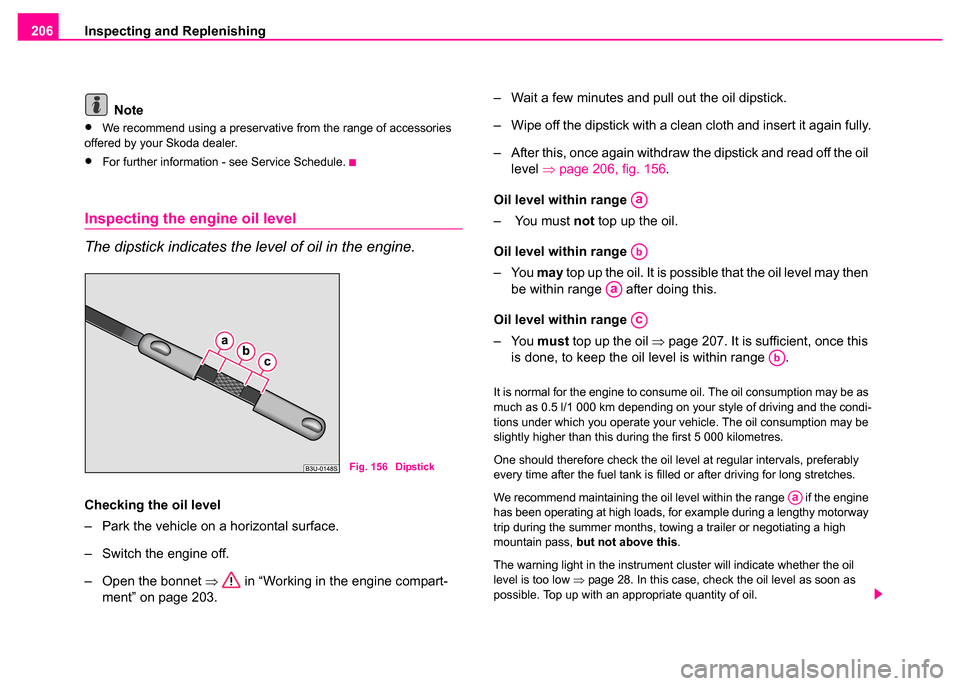
Inspecting and Replenishing
206
Note
•We recommend using a preservative from the range of accessories
offered by your Skoda dealer.
•For further information - see Service Schedule.
Inspecting the engine oil level
The dipstick indicates the level of oil in the engine.
Checking the oil level
– Park the vehicle on a horizontal surface.
– Switch the engine off.
– Open the bonnet ⇒ in “Working in the engine compart-
ment” on page 203. – Wait a few minutes and pull out the oil dipstick.
– Wipe off the dipstick with a clean cloth and insert it again fully.
– After this, once again withdraw the dipstick and read off the oil
level ⇒page 206, fig. 156 .
Oil level within range
– You must not top up the oil.
Oil level within range
–You may top up the oil. It is possible that the oil level may then
be within range after doing this.
Oil level within range
–You must top up the oil ⇒page 207. It is sufficient, once this
is done, to keep the oil level is within range .
It is normal for the engine to consume oil. The oil consumption may be as
much as 0.5 l/1 000 km depending on your style of driving and the condi-
tions under which you operate your vehicle. The oil consumption may be
slightly higher than this during the first 5 000 kilometres.
One should therefore check the oil level at regular intervals, preferably
every time after the fuel tank is filled or after driving for long stretches.
We recommend maintaining the oil level within the range if the engine
has been operating at high loads, for example during a lengthy motorway
trip during the summer months, towing a trailer or negotiating a high
mountain pass, but not above this .
The warning light in the instrument cluster will indicate whether the oil
level is too low ⇒page 28. In this case, check the oil level as soon as
possible. Top up with an appropriate quantity of oil.
Fig. 156 Dipstick
Aa
Ab
Aa
Ac
Ab
Aa
Page 210 of 259

Inspecting and Replenishing209
Using the systemSafetyDriving TipsGeneral MaintenanceBreakdown assistanceTechnical Data
– Open the bonnet ⇒ in “Working in the engine compart-
ment” on page 203.
– Check the level of coolant in the coolant expansion bottle ⇒fig. 157. The coolant level when the engine is cold must lie
between the “MIN” and “MAX” markings. The level may also
rise slightly above the “MAX” marking when the engine is
warm.
If the coolant level in the reservoir is too low, this is indicated by the
warning light in the instrument cluster ⇒ page 28. We nevertheless
recommend inspecting the coolant level directly at the reservoir from time
to time.
Loss of coolant
A loss of coolant is first and foremost an indication of a leak in the
system. You should not merely top up the coolant in the reservoir. It is also
important to have the cooling system inspected without delay by a Škoda
dealer.
Losses can only occur through the pressure relief in the cap of the coolant
expansion bottle which is completely free of leaks if the coolant boils as a
result of overheating and is forced out of the cooling system.
One should contact a Skoda dealer as soon as possible if the source of
overheating itself cannot be determined and removed, since there may be
grave damage to the engine.
Replenishing the coolant
– Switch the engine off.
– Allow the engine to cool down. – Place a cloth over the cap of the coolant expansion reservoir
⇒page 208, fig. 157 and unscrew the cap carefully by
turning it to the left ⇒.
– Top up the coolant.
– Screw on the cap tight until it is heard to lock.
The coolant which you use for replenishing the system, must comply with
certain specifications ⇒page 208, “Coolant”. Do not use an alternative
additive if the coolant additive G12°PLUS is not available in exceptional
cases. Just top up the system with water and as soon as possible arrange
adjustment to correct the mixing ratio of water and coolant additive again
by a Škoda dealer.
Only use fresh coolant for topping up the system.
Do not fill up over the “MAX” marking! Excess coolant which is heated up
is forced out of the cooling system through the pressure relief valve in the
cap of the coolant compensation bottle.
Wait until the engine has cooled down for a system which has suffered a
major loss of coolant before pouring in coolant. This is necessary to avoid
engine damage.
Do not continue your journey if for some reason it is not possible
under the conditions prevailing to top up with coolant. Switch off the
engine and obtain professional assistance from a Škoda dealer.
WARNING
•The cooling system is pressurized! Do not open the cap of the
coolant expansion bottle if the engine is still hot - risk of
scalding!
Page 212 of 259
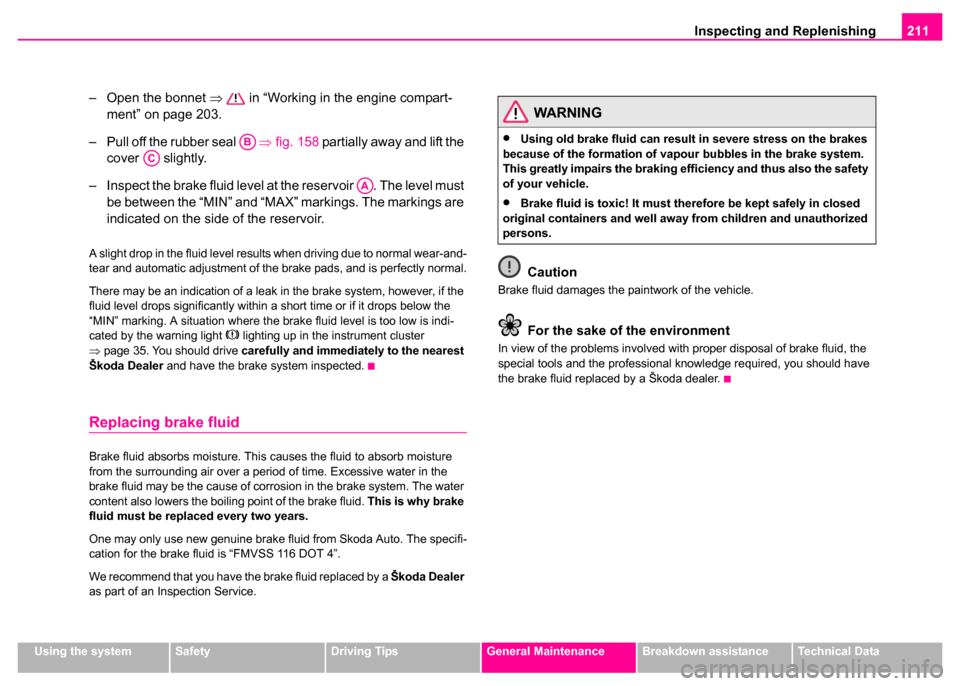
Inspecting and Replenishing211
Using the systemSafetyDriving TipsGeneral MaintenanceBreakdown assistanceTechnical Data
– Open the bonnet ⇒ in “Working in the engine compart-
ment” on page 203.
– Pull off the rubber seal ⇒fig. 158 partially away and lift the
cover slightly.
– Inspect the brake fluid level at the reservoir . The level must be between the “MIN” and “MAX” markings. The markings are
indicated on the side of the reservoir.
A slight drop in the fluid level results when driving due to normal wear-and-
tear and automatic adjustment of the brake pads, and is perfectly normal.
There may be an indication of a leak in the brake system, however, if the
fluid level drops significantly within a short time or if it drops below the
“MIN” marking. A situation where the brake fluid level is too low is indi-
cated by the warning light
lighting up in the instrument cluster
⇒ page 35. You should drive carefully and immediately to the nearest
Škoda Dealer and have the brake system inspected.
Replacing brake fluid
Brake fluid absorbs moisture. This causes the fluid to absorb moisture
from the surrounding air over a period of time. Excessive water in the
brake fluid may be the cause of corrosion in the brake system. The water
content also lowers the boiling point of the brake fluid. This is why brake
fluid must be replaced every two years.
One may only use new genuine brake fluid from Skoda Auto. The specifi-
cation for the brake fluid is “FMVSS 116 DOT 4”.
We recommend that you have the brake fluid replaced by a Škoda Dealer
as part of an Inspection Service.
Caution
Brake fluid damages the paintwork of the vehicle.
For the sake of the environment
In view of the problems involved with proper disposal of brake fluid, the
special tools and the professional knowledge required, you should have
the brake fluid replaced by a Škoda dealer.
AB
AC
AA
WARNING
•Using old brake fluid can result in severe stress on the brakes
because of the formation of vapour bubbles in the brake system.
This greatly impairs the braking efficiency and thus also the safety
of your vehicle.
•Brake fluid is toxic! It must therefore be kept safely in closed
original containers and well away from children and unauthorized
persons.
Page 243 of 259
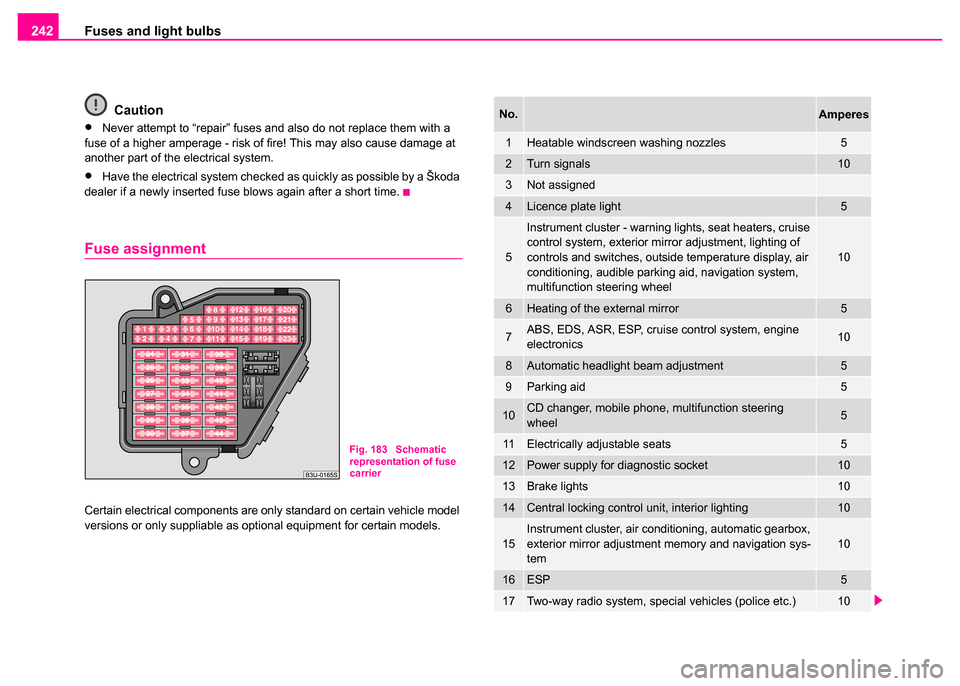
Fuses and light bulbs
242
Caution
•Never attempt to “repair” fuses and also do not replace them with a
fuse of a higher amperage - risk of fire! This may also cause damage at
another part of the electrical system.
•Have the electrical system checked as quickly as possible by a Škoda
dealer if a newly inserted fuse blows again after a short time.
Fuse assignment
Certain electrical components are only standard on certain vehicle model
versions or only suppliable as optional equipment for certain models.
Fig. 183 Schematic
representation of fuse
carrier
No.Amperes
1Heatable windscreen washing nozzles5
2Turn signals10
3Not assigned
4Licence plate light5
5
Instrument cluster - warning lights, seat heaters, cruise
control system, exterior mirror adjustment, lighting of
controls and switches, outside temperature display, air
conditioning, audible parking aid, navigation system,
multifunction steering wheel
10
6Heating of the external mirror5
7ABS, EDS, ASR, ESP, cruise control system, engine
electronics10
8Automatic headlight beam adjustment5
9Parking aid5
10CD changer, mobile phone, multifunction steering
wheel5
11Electrically adjustable seats5
12Power supply for diagnostic socket10
13Brake lights10
14Central locking control unit, interior lighting10
15Instrument cluster, air conditioning, automatic gearbox,
exterior mirror adjustment memory and navigation sys-
tem10
16ESP5
17Two-way radio system, special vehicles (police etc.)10
Page 254 of 259
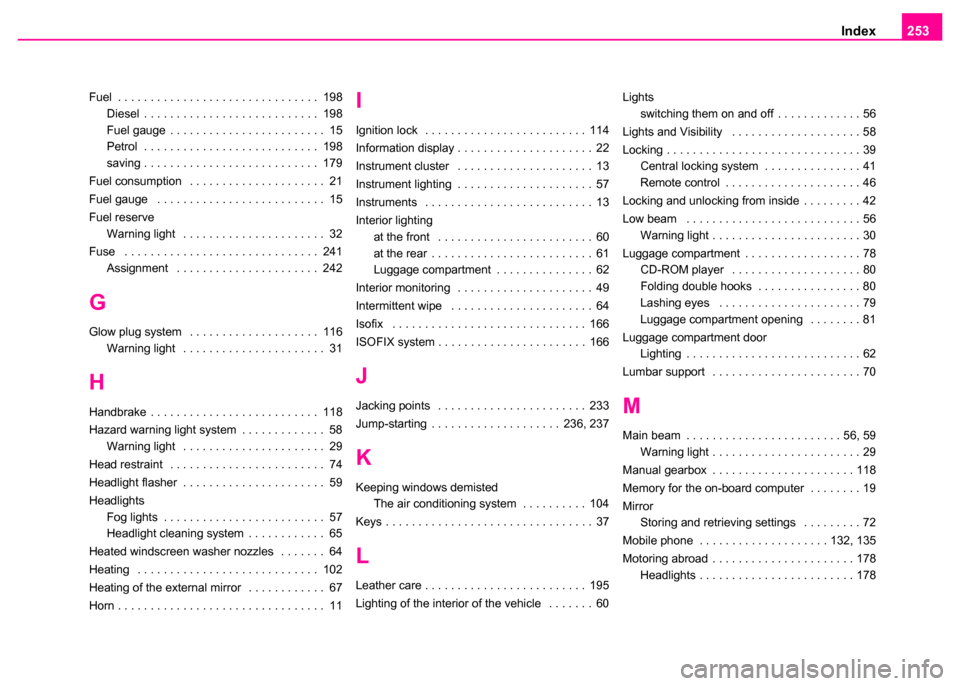
Index253
Fuel . . . . . . . . . . . . . . . . . . . . . . . . . . . . . . . 198
Diesel . . . . . . . . . . . . . . . . . . . . . . . . . . . 198
Fuel gauge . . . . . . . . . . . . . . . . . . . . . . . . 15
Petrol . . . . . . . . . . . . . . . . . . . . . . . . . . . 198
saving . . . . . . . . . . . . . . . . . . . . . . . . . . . 179
Fuel consumption . . . . . . . . . . . . . . . . . . . . . 21
Fuel gauge . . . . . . . . . . . . . . . . . . . . . . . . . . 15
Fuel reserve Warning light . . . . . . . . . . . . . . . . . . . . . . 32
Fuse . . . . . . . . . . . . . . . . . . . . . . . . . . . . . . 241 Assignment . . . . . . . . . . . . . . . . . . . . . . 242
G
Glow plug system . . . . . . . . . . . . . . . . . . . . 116Warning light . . . . . . . . . . . . . . . . . . . . . . 31
H
Handbrake . . . . . . . . . . . . . . . . . . . . . . . . . . 118
Hazard warning light system . . . . . . . . . . . . . 58Warning light . . . . . . . . . . . . . . . . . . . . . . 29
Head restraint . . . . . . . . . . . . . . . . . . . . . . . . 74
Headlight flasher . . . . . . . . . . . . . . . . . . . . . . 59
Headlights Fog lights . . . . . . . . . . . . . . . . . . . . . . . . . 57
Headlight cleaning system . . . . . . . . . . . . 65
Heated windscreen washer nozzles . . . . . . . 64
Heating . . . . . . . . . . . . . . . . . . . . . . . . . . . . 102
Heating of the external mirror . . . . . . . . . . . . 67
Horn . . . . . . . . . . . . . . . . . . . . . . . . . . . . . . . . 11
I
Ignition lock . . . . . . . . . . . . . . . . . . . . . . . . . 114
Information display . . . . . . . . . . . . . . . . . . . . . 22
Instrument cluster . . . . . . . . . . . . . . . . . . . . . 13
Instrument lighting . . . . . . . . . . . . . . . . . . . . . 57
Instruments . . . . . . . . . . . . . . . . . . . . . . . . . . 13
Interior lighting at the front . . . . . . . . . . . . . . . . . . . . . . . . 60
at the rear . . . . . . . . . . . . . . . . . . . . . . . . . 61
Luggage compartment . . . . . . . . . . . . . . . 62
Interior monitoring . . . . . . . . . . . . . . . . . . . . . 49
Intermittent wipe . . . . . . . . . . . . . . . . . . . . . . 64
Isofix . . . . . . . . . . . . . . . . . . . . . . . . . . . . . . 166
ISOFIX system . . . . . . . . . . . . . . . . . . . . . . . 166
J
Jacking points . . . . . . . . . . . . . . . . . . . . . . . 233
Jump-starting . . . . . . . . . . . . . . . . . . . . 236, 237
K
Keeping windows demisted The air conditioning system . . . . . . . . . . 104
Keys . . . . . . . . . . . . . . . . . . . . . . . . . . . . . . . . 37
L
Leather care . . . . . . . . . . . . . . . . . . . . . . . . . 195
Lighting of the interior of the vehicle . . . . . . . 60 Lights
switching them on and off . . . . . . . . . . . . . 56
Lights and Visibility . . . . . . . . . . . . . . . . . . . . 58
Locking . . . . . . . . . . . . . . . . . . . . . . . . . . . . . . 39 Central locking system . . . . . . . . . . . . . . . 41
Remote control . . . . . . . . . . . . . . . . . . . . . 46
Locking and unlocking from inside . . . . . . . . . 42
Low beam . . . . . . . . . . . . . . . . . . . . . . . . . . . 56 Warning light . . . . . . . . . . . . . . . . . . . . . . . 30
Luggage compartment . . . . . . . . . . . . . . . . . . 78 CD-ROM player . . . . . . . . . . . . . . . . . . . . 80
Folding double hooks . . . . . . . . . . . . . . . . 80
Lashing eyes . . . . . . . . . . . . . . . . . . . . . . 79
Luggage compartment opening . . . . . . . . 81
Luggage compartment door Lighting . . . . . . . . . . . . . . . . . . . . . . . . . . . 62
Lumbar support . . . . . . . . . . . . . . . . . . . . . . . 70
M
Main beam . . . . . . . . . . . . . . . . . . . . . . . . 56, 59 Warning light . . . . . . . . . . . . . . . . . . . . . . . 29
Manual gearbox . . . . . . . . . . . . . . . . . . . . . . 118
Memory for the on-board computer . . . . . . . . 19
Mirror Storing and retrieving settings . . . . . . . . . 72
Mobile phone . . . . . . . . . . . . . . . . . . . . 132, 135
Motoring abroad . . . . . . . . . . . . . . . . . . . . . . 178 Headlights . . . . . . . . . . . . . . . . . . . . . . . . 178
Page 256 of 259
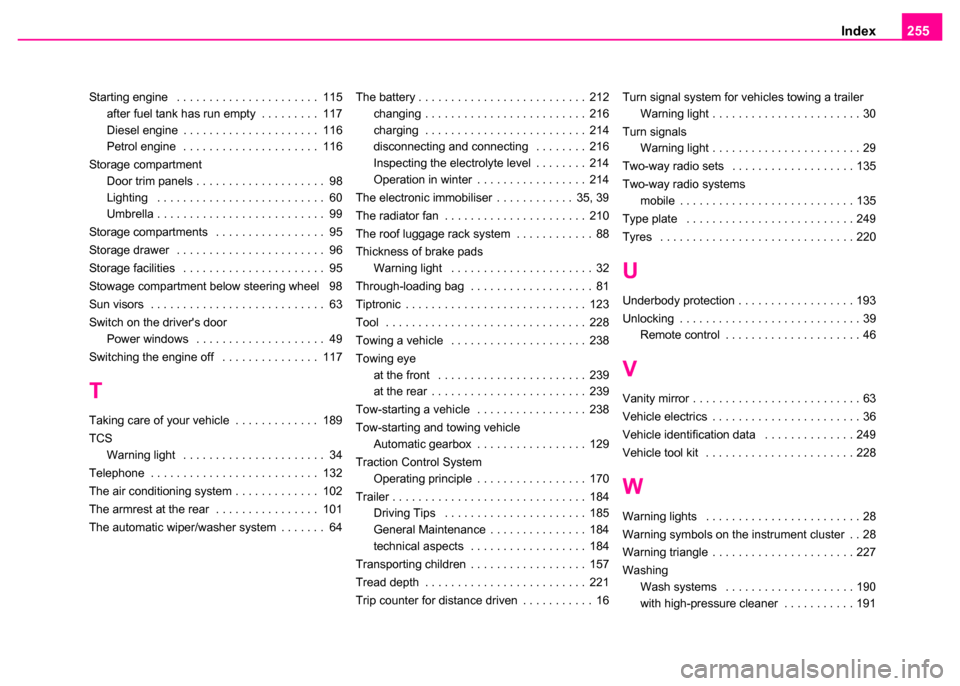
Index255
Starting engine . . . . . . . . . . . . . . . . . . . . . . 115
after fuel tank has run empty . . . . . . . . . 117
Diesel engine . . . . . . . . . . . . . . . . . . . . . 116
Petrol engine . . . . . . . . . . . . . . . . . . . . . 116
Storage compartment Door trim panels . . . . . . . . . . . . . . . . . . . . 98
Lighting . . . . . . . . . . . . . . . . . . . . . . . . . . 60
Umbrella . . . . . . . . . . . . . . . . . . . . . . . . . . 99
Storage compartments . . . . . . . . . . . . . . . . . 95
Storage drawer . . . . . . . . . . . . . . . . . . . . . . . 96
Storage facilities . . . . . . . . . . . . . . . . . . . . . . 95
Stowage compartment below steering wheel 98
Sun visors . . . . . . . . . . . . . . . . . . . . . . . . . . . 63
Switch on the driver's door Power windows . . . . . . . . . . . . . . . . . . . . 49
Switching the engine off . . . . . . . . . . . . . . . 117
T
Taking care of your vehicle . . . . . . . . . . . . . 189
TCS Warning light . . . . . . . . . . . . . . . . . . . . . . 34
Telephone . . . . . . . . . . . . . . . . . . . . . . . . . . 132
The air conditioning system . . . . . . . . . . . . . 102
The armrest at the rear . . . . . . . . . . . . . . . . 101
The automatic wiper/washer system . . . . . . . 64 The battery . . . . . . . . . . . . . . . . . . . . . . . . . . 212
changing . . . . . . . . . . . . . . . . . . . . . . . . . 216
charging . . . . . . . . . . . . . . . . . . . . . . . . . 214
disconnecting and connecting . . . . . . . . 216
Inspecting the electrolyte level . . . . . . . . 214
Operation in winter . . . . . . . . . . . . . . . . . 214
The electronic immobiliser . . . . . . . . . . . . 35, 39
The radiator fan . . . . . . . . . . . . . . . . . . . . . . 210
The roof luggage rack system . . . . . . . . . . . . 88
Thickness of brake pads Warning light . . . . . . . . . . . . . . . . . . . . . . 32
Through-loading bag . . . . . . . . . . . . . . . . . . . 81
Tiptronic . . . . . . . . . . . . . . . . . . . . . . . . . . . . 123
Tool . . . . . . . . . . . . . . . . . . . . . . . . . . . . . . . 228
Towing a vehicle . . . . . . . . . . . . . . . . . . . . . 238
Towing eye at the front . . . . . . . . . . . . . . . . . . . . . . . 239
at the rear . . . . . . . . . . . . . . . . . . . . . . . . 239
Tow-starting a vehicle . . . . . . . . . . . . . . . . . 238
Tow-starting and towing vehicle Automatic gearbox . . . . . . . . . . . . . . . . . 129
Traction Control System Operating principle . . . . . . . . . . . . . . . . . 170
Trailer . . . . . . . . . . . . . . . . . . . . . . . . . . . . . . 184 Driving Tips . . . . . . . . . . . . . . . . . . . . . . 185
General Maintenance . . . . . . . . . . . . . . . 184
technical aspects . . . . . . . . . . . . . . . . . . 184
Transporting children . . . . . . . . . . . . . . . . . . 157
Tread depth . . . . . . . . . . . . . . . . . . . . . . . . . 221
Trip counter for distance driven . . . . . . . . . . . 16 Turn signal system for vehicles towing a trailer
Warning light . . . . . . . . . . . . . . . . . . . . . . . 30
Turn signals Warning light . . . . . . . . . . . . . . . . . . . . . . . 29
Two-way radio sets . . . . . . . . . . . . . . . . . . . 135
Two-way radio systems mobile . . . . . . . . . . . . . . . . . . . . . . . . . . . 135
Type plate . . . . . . . . . . . . . . . . . . . . . . . . . . 249
Tyres . . . . . . . . . . . . . . . . . . . . . . . . . . . . . . 220
U
Underbody protection . . . . . . . . . . . . . . . . . . 193
Unlocking . . . . . . . . . . . . . . . . . . . . . . . . . . . . 39 Remote control . . . . . . . . . . . . . . . . . . . . . 46
V
Vanity mirror . . . . . . . . . . . . . . . . . . . . . . . . . . 63
Vehicle electrics . . . . . . . . . . . . . . . . . . . . . . . 36
Vehicle identification data . . . . . . . . . . . . . . 249
Vehicle tool kit . . . . . . . . . . . . . . . . . . . . . . . 228
W
Warning lights . . . . . . . . . . . . . . . . . . . . . . . . 28
Warning symbols on the instrument cluster . . 28
Warning triangle . . . . . . . . . . . . . . . . . . . . . . 227
WashingWash systems . . . . . . . . . . . . . . . . . . . . 190
with high-pressure cleaner . . . . . . . . . . . 191